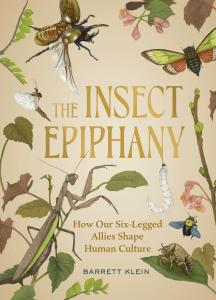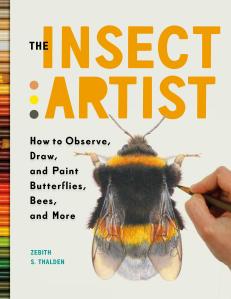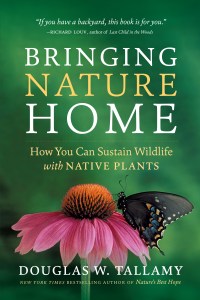Bug Books!

From identifying butterflies to planting for pollinators discover buzz-worthy books about insects. Here’s a list of must-read nonfiction books that delve into the captivating lives of bugs and the critical role they play in our ecosystems.
From entomologist Barrett Klein comes a buzz-worthy exploration of the many ways insects have affected human society, history, and culture
As heard on Science Friday.
Insects surround us. They fuel life on Earth through their roles as pollinators, predators, and prey, but rarely do we consider the outsize influence they have had on our culture and civilization. Their anatomy and habits inform how we live, work, create art, and innovate. Featuring nearly 250 color images—from ancient etchings to avant-garde art, from bug-based meals to haute couture—The Insect Epiphany proves that our world would look very different without insects, not just because they are crucial to our ecosystems, but because they have shaped and inspired so many aspects of what makes us human.
“Art and science collide beautifully” in this step-by-step, fully illustrated guide to drawing and painting the wonderful world of insects (Lila Higgins).
The Insect Artist offers a complete course in illustration and lifelike artwork. The 15 projects are designed to build on one another, beginning with techniques that strengthen drawing and acrylic painting skills. More advanced projects focus on design principles, realistic environments, and creative challenges. Clear instructions and visual demonstrations describe each step of the process and reference photos show the anatomy and coloration of each insect. Short outdoor exercises are included as lessons on actively observing nature. This is a book for artists of all levels and anyone interested in rediscovering the natural world through artistic expression.Packed with creative tips:
- Achieve rich colors, surface textures, and spatial depth
- Measure proportions accurately
- Simplify tricky forms and patterns
- Establish an inspiring and supportive art practice
Science, nature, and adventure come together in this riveting account of a solo bike trip along the migratory path of the monarch butterfly.
Sara Dykman made history when she became the first person to bicycle alongside monarch butterflies on their storied annual migration—a round-trip adventure that included three countries and more than 10,000 miles. Equally remarkable, she did it solo, on a bike cobbled together from used parts.
In Bicycling with Butterflies—praised as “poetic” (Publishers Weekly) and called “a collective cry for climate action” (Booklist)—Dykman recounts her incredible journey. We’re beside her as she navigates unmapped roads in foreign countries, checks roadside milkweed for monarch eggs, and shares her passion with eager schoolchildren, skeptical bar patrons, and unimpressed border officials. We also meet some of the ardent monarch stewards who supported her efforts, from citizen scientists and researchers to farmers and high-rise city dwellers.
With both humor and humility, Dykman offers a compelling story, confirming the urgency of saving the threatened monarch migration—and the other threatened systems of nature that affect the survival of us all.
Honey bees get all the press, but the fascinating story of North America’s native bees—endangered species essential to our ecosystems and food supplies—is just as crucial. Through interviews with farmers, gardeners, scientists, and bee experts, Our Native Bees explores the importance of native bees and focuses on why they play a key role in gardening and agriculture. The people and stories are compelling: Paige Embry goes on a bee hunt with the world expert on the likely extinct Franklin’s bumble bee, raises blue orchard bees in her refrigerator, and learns about an organization that turns the out-of-play areas in golf courses into pollinator habitats. Our Native Bees is a fascinating, must-read for fans of natural history and science and anyone curious about bees.
The Ultimate Wildlife Habitat Garden is a beginner-friendly handbook that will help you create a beautiful garden that attracts birds, bees, and butterflies. Garden expert Stacy Tornio makes it easy by explaining which plants attract specific creatures. Want birds? Plant black-eyed Susans. Looking to attract bumble bees? Choose bee balm. If you are looking to build a garden from scratch, there are ten plans you can choose from, including a hummingbird garden, a birdseed garden, a low-maintenance garden, a shade garden, and even drought-resistant options. You’ll also find expert advice on finding the right feeder, avoiding pesticides, and choosing native plants.
Welcome the world’s most exquisite visitors to your garden! Gardening for Butterflies, by the experts at the Xerces Society, introduces you to a variety of butterflies who need our help, and shows you how to design a habitat where they will thrive. This optimistic call to arms is packed with everything you need to create a beautiful, pollinator-friendly garden. You will learn why butterflies matter, why they are in danger, and what simple steps we can take to make a difference. You’ll also learn how to choose the right plants and how to create a garden that flutters and flourishes with life.
“Explains how your garden can be a thriving, balanced community that gives more to your landscape than it takes.” —Douglas W. Tallamy, author of The Nature of Oaks and Nature’s Best Hope
The birds, mammals, reptiles, and insects that inhabit our yards and gardens are overwhelmingly on our side—they are not our enemies, but instead our allies. They pollinate our flowers and vegetable crops, and they keep pests in check. In Garden Allies, Frédérique Lavoipierre shares fascinating portraits of these creatures, describing their life cycles and showing how they keep the garden’s ecology in balance. Also included is helpful information on how to nurture and welcome these valuable creatures into your garden. With beautiful pen-and-ink drawings by Craig Latker, Garden Allies invites you to make friends with the creatures that fill your garden—the reward is a renewed sense of nature’s beauty and a garden humming with life.
This “miracle” of a guide book shows readers how to maintain harmony within their environment (Margaret Renkl, The Washington Post).
In his groundbreaking book Bringing Nature Home, Douglas W. Tallamy reveals the unbreakable link between native plant species and native wildlife—native insects cannot, or will not, eat alien plants. When native plants disappear, the insects disappear, impoverishing the food source for birds and other animals. As development and habitat destruction accelerate, there are increasing pressures on wildlife populations.
Luckily, there is an important and simple step we can all take to help reverse this alarming trend: everyone with access to a patch of earth can make a significant contribution toward sustaining biodiversity by simply choosing native plants. By acting on Douglas Tallamy’s practical and achievable recommendations, we can all make a difference.
Ideal for birders, hikers, and foragers, the Timber Press Field Guides are the perfect tools for loving where you live.
Butterflies of the Pacific Northwest is a comprehensive field guide to the region’s most common and distinctive butterflies. Profiles include preferred common name for both genus and species, conservation status, the look and distinguishing traits of each butterfly, habitat, and range, and much more. Additional information includes a brief introduction to how butterflies work and details on ecology and conservation.
- Covers Washington, Oregon, western Idaho, northern California, and British Columbia
- Describes and illustrates 200 of the most common and distinctive butterflies
- 712 spectacular photographs, 200 range maps, and 17 illustrative plates for comparing and identifying species
- Clear color-coded layout








